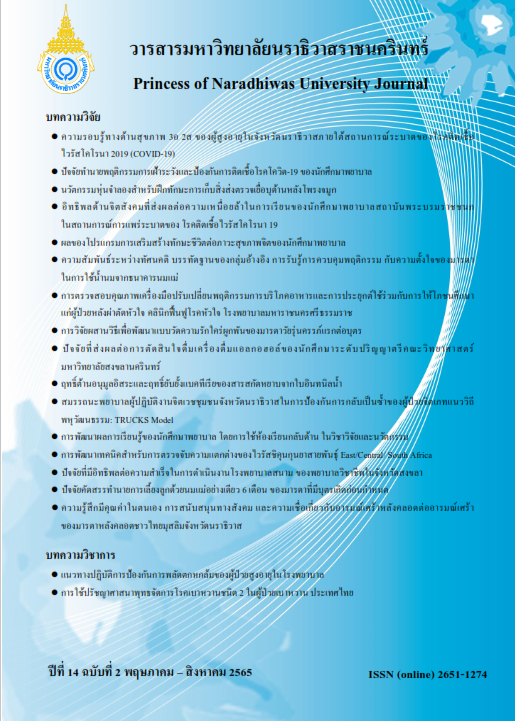Development of Differential Detection Chikungunya Virus in East/Central/South Africa Lineage
Keywords:
Chikungunya virus, East/Central/South Africa lineage, Multiplex PCRAbstract
Chikungunya fever (CHIKF) is a mosquito-borne disease endemic to tropical regions. It is caused by the Chikungunya virus (CHIKV) and infects over one million people per year. CHIKV was first reported in Thailand in 1960 and a huge outbreak occurred in 2008-2009, which belonged to the East/Central/South Africa (ECSA) lineage (E1: A226V mutation). In this study, we analyzed the CHIKV E1 and E2 protein sequences in Thailand isolates and developed a method for detecting wild-type and mutant forms of the highly invasive ECSA lineage using one step multiplex PCR assay. A phylogenetic tree revealed that CHIKV found in Thailand during 2018–2019 represented the ECSA lineage and contained a double mutation (A226V and K211E) of the E1 protein. An additional E1 residue change, V264A, in the E2 protein of the ECSA lineage was also observed. Therefore, we designed specific primers and optimized multiplex PCR conditions to detect E1:K211E, E1:A266, and E2:V264A. The multiplex PCR results indicated that a PCR mixture containing 50, 100, or 200 ng/µl of DNA template, 1.5 mM MgCl2, 10 mM Tris-HCL (pH 9.1), 0.2 mM dNTP, 0.25 µM of primer mix, and 2.5 units of DNA polymerase amplified A226, K211E, and V264A in one reaction. The results indicate that this assay can readily detect the ECSA strain in one reaction, which will facilitate the routine, high-throughput diagnosis of CHIKV.
References
Agarwal, A., Gupta, S., Yadav, A.K., Nema, R.K., Ansari, K., & Biswas, D. (2019). Molecular and phylogenetic analysis of Chikungunya virus in Central India during 2016 and 2017 outbreaks reveal high similarity with recent New Delhi and Bangladesh strains. Infection, Genetic and Evolution, 75.
Agarwal, A., Sharma, A.K., Sukumaran, D., Parida, M., & Dash, P.K. (2016). Two novel epistatic mutations (E1:K211E and E2:V264A) in structural proteins of Chikungunya virus enhance fitness in Aedes aegypti. Virology, 497, 59-68.
Burt, F.J., Chen, W., Miner, J.J., Lenschow, D.J., Merits, A., Schnettler, E., . . . Mahalingam, S. (2017). Chikungunya virus: an update on the biology and pathogenesis of this emerging pathogen. The Lancet Infectious Diseases, 17(4), e107-e117.
Chansaenroj, J., Wanlapakorn, N., Ngamsaithong, C., Thongmee, T., Na Nakorn, N., Siriyasatien, P., . . . Poovorawan, Y. (2020). Genome sequences of chikungunya virus isolates from an outbreak in southwest Bangkok in 2018. Archives of Virology, 165(2), 445-450.
Bureau of vetor bone disease (2018). Annual report 2018 Retrieved from 15 November 2021 https://ddc.moph.go.th/uploads/ckeditor/6f4922f45568161a8cdf4ad2299f6d23/files/Report/Annual%20Report/2561.pdf.
Bureau of vetor bone disease. (2021). Annual report 2021. Retrieved from 15 November 2021 https://drive.google.com/file/d/1TwANFg78Y5jx_PTNwMWMdedn07tU2GqX/view.
Chansaenroj, J., Wanlapakorn, N., Ngamsaithong, C., Thongmee, T., Na Nakorn, N., Siriyasatien, P., Poovorawan, Y. (2020). Genome sequences of chikungunya virus isolates from an outbreak in southwest Bangkok in 2018. Archives of Virology, 165(2), 445-450.
Ganesan, V.K., Duan, B., & Reid, S.P. (2017). Chikungunya Virus: Pathophysiology, Mechanism, and Modeling. Viruses, 9(12).
Intayot, P., Phumee, A., Boonserm, R., Sor-Suwan, S., Buathong, R., Wacharapluesadee, S., . . . Siriyasatien, P. (2019). Genetic Characterization of Chikungunya Virus in Field-Caught Aedes aegypti Mosquitoes Collected during the Recent Outbreaks in 2019, Thailand. Pathogens (Basel, Switzerland), 8(3), 121.
Kumar, S., Stecher, G., Li, M., Knyaz, C., & Tamura, K. (2018). MEGA X: Molecular Evolutionary Genetics Analysis across Computing Platforms. Molecular Biology and Evolution, 35(6), 1547-1549.
Markoulatos, P., Siafakas, N., & Moncany, M. (2002). Multiplex polymerase chain reaction: a practical approach. Journal of Clinical Laboratory Analysis, 16(1), 47-51.
Patil, J., More, A., Patil, P., Jadhav, S., Newase, P., Agarwal, M., Cherian, S.S. (2018). Genetic characterization of chikungunya viruses isolated during the 2015-2017 outbreaks in different states of India, based on their E1 and E2 genes. Archives of Virology, 163(11), 3135-3140.
Pongsiri, P., Praianantathavorn, K., Theamboonlers, A., Payungporn, S., & Poovorawan, Y. (2012). Multiplex real-time RT-PCR for detecting chikungunya virus and dengue virus. Asian Pacific Journal of Tropical Medicine, 5(5), 342-346.
Pulmanausahakul, R., Roytrakul, S., Auewarakul, P., & Smith, D. R. (2011). Chikungunya in Southeast Asia: understanding the emergence and finding solutions. International Journal of Infectious Diseases, 15(10), e671-676.
Rianthavorn, P., Prianantathavorn, K., Wuttirattanakowit, N., Theamboonlers, A., & Poovorawan, Y. (2010). An outbreak of chikungunya in southern Thailand from 2008 to 2009 caused by African strains with A226V mutation. International Journal of Infectious Diseases, 14 Suppl 3, e161-165.
Sharif, N., Sarkar, M.K., Ferdous, R.N., Ahmed, S.N., Billah, M.B., Talukder, A.A., . . . Dey, S.K. (2021). Molecular Epidemiology, Evolution and Reemergence of Chikungunya Virus in South Asia. Frontiers in Microbiology, 12(1411).
Silva, L.A., & Dermody, T.S. (2017). Chikungunya virus: epidemiology, replication, disease mechanisms, and prospective intervention strategies. The Journal of Clinical Investigation, 127(3), 737-749.
Staples, J.E., Breiman, R.F., & Powers, A.M. (2009). Chikungunya fever: an epidemiological review of a re-emerging infectious disease. Clinical Infectious Disease, 49(6), 942-948.
Suangto P., U.T. (2009). Chikungunya fever Annual Epidemiological Surveillance Report Retrieved from http://www.boe.moph.go.th/Annual/Annual%202552/Main.html. Retrieved 22 June 2019
Yactayo, S., Staples, J.E., Millot, V., Cibrelus, L., & Ramon-Pardo, P. (2016). Epidemiology of Chikungunya in the Americas. Journal of the Infectious Diseases, 214(suppl 5), S441-s445.
Additional Files
Published
How to Cite
Issue
Section
License
Copyright (c) 2022 Princess of Naradhiwas University Journal

This work is licensed under a Creative Commons Attribution-NonCommercial-NoDerivatives 4.0 International License.




